Hyundai Accent
| Hyundai Accent | |
|---|---|
 | |
| Overview | |
| Manufacturer | Hyundai |
| Production | 1994–present |
| Body and chassis | |
| Class | Subcompact car (B) |
| Layout | Front-engine, front-wheel-drive |
| Chronology | |
| Predecessor | Hyundai Excel |
The Hyundai Accent (Korean: 현대 엑센트), or Hyundai Verna (현대 베르나) is a subcompact car produced by Hyundai. In Australia, the first generation models carried over the Hyundai Excel name used by the Accent's predecessor. The Accent was replaced in 2000 by the Hyundai Verna in South Korea, although most international markets, including the US, retained the "Accent" name. The "Accent" name is an abbreviation of Advanced Compact Car of Epoch-making New Technology.[1]
The Accent is produced for the Chinese market by Beijing Hyundai Co., a joint venture with Beijing Automotive Industry Corp. For the Russian market it was assembled by the TagAZ plant in Taganrog until 2011, and since 2011 it is assembled by the HMMR plant in Saint Petersburg and sold under the new name Hyundai Solaris. In Mexico, the Accent was marketed until 2014 by Chrysler as the Dodge Attitude, previously known as the Verna by Dodge. In Venezuela, Chrysler marketed these models as the Dodge Brisa until 2006. The Brisa was assembled by Mitsubishi Motors at its plant in Barcelona, Venezuela. Since 2002, the Accent had been the longest-running small family car sold in North America. In Puerto Rico, it was sold as the Hyundai Brio.
In 2008, Hyundai Accent was named the most dependable subcompact car by J.D. Power and Associates.[2]
First generation (X3; 1994)[]
| First generation (X3) | |
|---|---|
 Pre-facelift Hyundai Excel sedan (Australia) | |
| Overview | |
| Also called | Hyundai Accent Verna Hyundai Excel Hyundai Pony (France) Bimantara Cakra (Indonesia) Yueda-Kia Qianlima (China)[3][4][5] Dodge Brisa (Venezuela) |
| Production | 1994–1999 (South Korea) 1995–2006 (Egypt) 2002–2006 (China) 1996–2006 (Indonesia) |
| Assembly |
|
| Body and chassis | |
| Body style | 4-door sedan 3/5-door hatchback |
| Powertrain | |
| Engine | Petrol engines: 1.3 L Alpha SOHC 12V I4 1.5 L Alpha SOHC 12V I4 1.5 L Alpha II DOHC 16V I4 1.6 L Alpha II DOHC 16V I4 (China) |
| Transmission | 5-speed M5AF3 manual 4-speed A4AF2 automatic |
| Dimensions | |
| Wheelbase | 2,400 mm (94.5 in) |
| Length | 4,100 mm (161.4 in) (hatchback) 4,117 mm (162.1 in) (sedan) |
| Width | 1,620 mm (63.8 in) |
| Height | 1,395 mm (54.9 in) 1,410 mm (55.5 in) (Kia Qianlima) |
| Curb weight | 2,101–2,150 lb (953–975 kg) |
The Hyundai Accent (X3) was introduced as a replacement for the Excel in 1994 for the 1995 model year. It continued to be called Dodge Brisa in Venezuela or Hyundai Excel in some markets, such as the Netherlands, Belgium, Indonesia and Australia. In France, it was called the Hyundai Pony, in Indonesia, the pre-facelift model was called as Bimantara Cakra and in China, it was called the Kia Qianlima.
Markets[]
Australia[]
Australian cars were released in November 1994 available in Sprint and GX trims (three-door hatchback) or LX and GLX trims (four-door sedan and five-door hatchback). The upper-specification models (GX and GLX) had full cloth interior (as opposed to vinyl seat backings), height and lumbar support adjustments on the driver's seat, four-speaker sound system (instead of two), passenger vanity mirror, a tachometer, and power antenna as standard. GX three-doors also had a standard rear spoiler, while power steering was standard on all but the Sprint. There were also some special editions—the Classique sedan in 1996 with anti-lock brakes and the Sportz in 1999 and 2000 with alloy wheels and a rear spoiler. The overwhelming majority sold were the Sprint three-door, enticing buyers with free air-conditioning, driveaway pricing and from late 1998, standard power steering.
The facelift arrived in Australia in April 1997 with accompanying trim changes. The engine was a 1.5-liter G4EK SOHC unit with 91 hp (68 kW). From November 1997 onwards, this was upgraded to a twin cam (DOHC) G4FK version with 74 kW (99 hp) at 6000 rpm and torque of 134 N⋅m (99 lb⋅ft) at 4000 rpm. A double overhead cam (DOHC) engine was also available in America in the Accent GT but made a more-powerful 105 hp (78 kW) at 6000 rpm instead.[10] X3s with the DOHC engine are badged "Twin Cam".
In Australia, the X3 proved so popular (due to its reliability and low price[11][12][13]) that it was the third best-selling vehicle in the country in both 1996 and 1998. In the latter year, it achieved more than 44,000 sales (a 5.5% share of the total market), a record figure at the time, for an imported car. Between 1994 and 2000, some 200,000 X3s were sold in Australia, making it arguably the most successful imported vehicle in the country's history.
Romania[]
In 1998, Hyundai created a joint venture with Romanian manufacturer Dacia to produce the Accent in Romania, at Dacia's Mioveni plant.[14] Unfortunately, the deal failed and Dacia was bought by Renault.
United Kingdom[]
The Accent was sold in saloon (sedan), hatchback, and coupé form in the UK, with a choice of three engines for each: a 1.3 12v (85 hp), 1.5 12v (92 hp) and a 1.5 16v (105 hp) petrol. There was no diesel option. A GSi spec car was the top-specification Accent. The MVi-spec coupé version won particular praise for its handling agility in the UK. Although the Accent was cheap to buy and insure, its engines were quite thirsty; the 1.5-litre returned 33 mpg‑imp (8.6 L/100 km; 27 mpg‑US) average according to list figures.
United States[]
In the US, although manuals exist for Accents before and after 1999, a manual for 1999 Hyundai Accent has not been published. Additionally, owners of the 1999 model were informed by their dealers that the power output of the 1.5-liter engine was in fact rated at 88 horsepower (66 kW). Only the 3-door hatchback and 4-door sedan were offered.
Indonesia[]
In Indonesia, the Accent was assembled locally and marketed as the Bimantara Cakra from 1996 to 1998[15](alongside the Bimantara Nenggala/Hyundai Elantra) and only available as 4-door sedan with a fuel injected 1.5 liter 12-valve engine and 5-speed manual transmission. After the 1997 Asian financial crisis that affected Indonesia in 1998, Bimantara went bankrupt and the production facilities was taken over by Hyundai (also the first time Hyundai started selling their cars with their own brand in Indonesia) and reintroduced the Cakra as Accent, still with the 1.5 liter 12 valve engine but with the facelifted model and additional 4-speed automatic transmission variant from 1998 to 2001.[15] From 2001 to 2006, this generation was still on sale side by side with the second generation Accent (sold as Hyundai Verna) but as Hyundai Excel, specially for taxi fleets.
China[]
In China, the Hyundai Excel was branded as the Kia Qianlima under Dongfeng Yueda Kia. It came with either a 1.3 SOHC engine or a 1.6 liter engine DOHC engine. Production ran from December 2002 until November 2006. It had similar styling to the regular Hyundai Excel until it was given a facelift in 2005 featuring a new grille and foglamps. Trim levels included the 1.3 DLX, 1.3L GL (Manual), 1.3L GL (Automatic), 1.6 GLS (Manual) and the 1.6 GLS (Automatic). The only body style available was the 4 door sedan.[16]
Safety[]
The 1998 Hyundai Accent was crash-tested by the European New Car Assessment Programme and showed rather poor performance, scoring only 4 points out of 16 for frontal impact.[17] The passenger compartment became unstable in the crash test.[17] It was determined that there was an unacceptably high risk of chest injury during side impact crash, as a result, the car would not meet the minimum legal requirement in 1999.[17] The Swedish insurance company, Folksam, rates the 1st-gen Accent as one of the safest cars in its weight class.[18]
Gallery[]

Pre-facelift Hyundai Excel 3-door (Australia)

Pre-facelift Hyundai Excel 3-door (Australia)

Pre-facelift Hyundai Accent 3-door (Europe)

Facelift Hyundai Accent 3-door (United Kingdom)

Facelift Hyundai Accent 3-door (United Kingdom)

Pre-facelift Hyundai Excel 5-door (Australia)

Pre-facelift Hyundai Excel sedan (Australia)

Pre-facelift Hyundai Excel sedan (Australia)

Facelift Hyundai Excel sedan (Australia)

Facelift Hyundai Excel sedan (Australia)

facelift Hyundai Euro Accent (South Korea)

facelift Hyundai Euro Accent (South Korea)
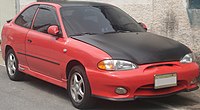
Hyundai Pro Accent

Hyundai Accent GT

Hyundai Accent GT (Malta)

Kia Qianlima (2003-2005; China)

Kia Qianlima (2005-2006; China)
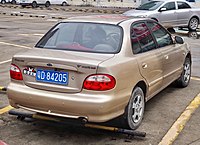
Kia Qianlima (2005-2006; China)

Bimantara Cakra (Indonesia)
Second generation (LC; 1999)[]
| Second generation (LC) | |
|---|---|
 Pre-facelift Hyundai Accent 3-door (Australia) | |
| Overview | |
| Also called | Hyundai Accent Verna Hyundai Brio Hyundai Verna Hyundai Super Pony Hyundai Avega (liftback, Indonesia) Hyundai Excel II (taxi fleet, Indonesia) Dodge Verna (Mexico) Giad Accent (Sudan) |
| Production | 1999–2005 (South Korea) 1999–2016 (India and later discontinued in India but export continued for Algerian market)[19][20] 2001–2012 (Russia)[21][22] 2001–2012 (Indonesia) |
| Assembly | Ulsan, South Korea Chennai, India (Hyundai Motor India) İzmit, Turkey (Hyundai Assan)[9] Taganrog, Russia (TagAZ)[23] Cairo, Egypt (Ghabbour Group)[7] Khartoum, Sudan (Giad)[24] Kerman, Iran (RVMCO)[25] Bekasi, Indonesia (Hyundai Indonesia Motor)[26] |
| Body and chassis | |
| Body style | 4-door sedan 3 and 5-door hatchback |
| Platform | Hyundai-Kia TB |
| Related | Hyundai Getz |
| Powertrain | |
| Engine |
|
| Transmission |
|
| Dimensions | |
| Wheelbase | 2,440 mm (96.1 in) |
| Length | 4,235 mm (166.7 in) (1999–02 sedan) 4,260 mm (167.7 in) (2002–05 sedan) 4,215 mm (165.9 in) (hatchback) |
| Width | 1,670 mm (65.7 in) (1999–02) 1,680 mm (66.1 in) (2002–05) |
| Height | 1,395 mm (54.9 in) |
| Curb weight | 990–1,140 kg (2,183–2,513 lb) |
The redesigned 1999 Accent (LC) sported a more angular body and increased dimensions. It received a minor facelift in 2003, and was given the model code LC2. When the Accent sedan underwent a 2006 redesign, the hatchback continued on sale during 2006 only in Canada, since the hatchback skipped the 2006 model year for the United States. But for Korea, it was the first model with the new nameplate: Verna.
The Accent got revised 1.3 and 1.5-litre engines, featuring various improvements to lower noise, vibration, and harshness. A 1.6-litre DOHC 16-valve replaced the 1.5-litre from 2001, with the 1.5 continuing to be available in some markets. This Accent was also the first to get a diesel version, with a 1.5-litre three-cylinder direct injection turbodiesel, which was badged CRDi.
Trim levels were GSi, CDX and MVi: this was standard on most export versions, although some European markets had their own designations with names like Dynamic=Version etc. Some markets used LS and GLS.
Marketing[]
- North America
In North America the Accent was available in GL, GLS and GT trim levels only, with the 1.5-litre engine at first, then the 1.6-litre engine from 2002. The GT version was similar to the MVi version marketed in Europe and Oceania, although the body kit was not as overtly hot hatch styled.
During 2003 in Canada, the hatchback was offered as a GS or GSi with a 1.5 L or 1.6 L engine, respectively. In 2004 the GS trim was equipped with the 1.6 L engine.
- Russia
It was sold in Russia until 2011 as the Hyundai Accent side-by-side with the 3rd generation model which is sold as the Hyundai Verna.
- India
It was launched in India in October 1999 as the "Accent" and was still in production after some minor facelifts;[19] the car was phased out in 2013 for local market.[27] A new variant of the India-made Hyundai Accent. The Accent GLS variant, which now adopts front airbags and ABS to meet the regulations on safety equipment on new vehicles, implies that the Accent could live on until 2017.
The GLS variant also comes with Air conditioning, power windows front and rear, power steering, central locking, Radio-CD-MP3 audio system, and front fog lights. It is the best selling model produce by Hyundai's Chennai plant. It has been restyled twice – in 2004 and 2010 – and is strapped with a 1.5-liter four-cylinder petrol engine matched to a five-speed manual gearbox.
- Egypt
In Egypt, it still remains on sale as of January 2019.
- Indonesia
In Indonesia, it was sold from 2001 to 2012 and marketed in 3 different names. At first it was marketed in a 4-door body style as "Accent Verna" (2001-2007), available with three trim levels, G, GL and GLS. In 2005, a facelifted version based from G trim was sold for taxi fleet as "Excel II". Later from 2007, both Accent Verna and Excel II 4-door sedan was replaced with a 5-door liftback body style, sold as "Avega" until 2012.
Engines[]
- 1.3 L 12-valve SOHC Alpha I4 I4, 82 hp (61 kW) from 2000–2003, 86 hp (64 kW) from 2003–2005 (except cars with Air conditioning, rated at 82 hp).
- 1.5 L 12-valve SOHC Alpha I4, 92 hp (69 kW) @5500 rpm and 97 lb⋅ft (132 N⋅m) @2900 rpm, 0–100 km/h: 12.0 sec., top speed: 181 km/h (112 mph)
- 1.5 L 16-valve DOHC Alpha I4, 102 hp (76 kW) and 98 lb⋅ft (133 N⋅m)
- 0–100 km/h: 11.6 sec., top speed: 185 km/h (115 mph)
- 1.6 L 16-valve DOHC Alpha I4, 106 hp (79 kW) and 106 lb⋅ft (144 N⋅m)
- 0–100 km/h: 10.9 sec., top speed: 189 km/h (117 mph)
- 1.5 L CRDi (R 315) I3, 82 hp (61 kW) and 137 lb⋅ft (186 N⋅m)
- 0–100 km/h: 14.0 sec., top speed: 170 km/h (106 mph)
Safety[]
A pre-2003 model (a three-door hatchback) was crash tested by Australian Australasian New Car Assessment Program (ANCAP) under the rules as adopted by Euro NCAP. It scored 10.76 out of 16 points for frontal offset impact and 10.96 out of 16 in the side impact test.[28]
The same un-restyled model, a four-door sedan had been crash tested by Russian magazine Autoreview in 2005.[29] Test was carried out to the Euro NCAP regulations. Despite the lack of airbags (which are not available in the cheapest version of Accent on the Russian market) it scored 9.9 of 16 for frontal impact.[30]
The 2003 restyled model was tested by ANCAP as well. The three-door hatchback scored 9.19 of 16 points for frontal impact and 9.76 out of 16 in the side impact crash test.[31]
Gallery[]

Pre-facelift Hyundai Accent 3-door (US)

Pre-facelift Hyundai Accent 5-door (Australia)

Pre-facelift Hyundai Accent 5-door (Europe)

Pre-facelift Hyundai Accent sedan (USA)

Pre-facelift Hyundai Verna sedan (South Korea)

Facelift Hyundai Verna sedan (South Korea)

Facelift Hyundai Accent sedan (US)
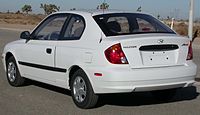
Facelift Hyundai Accent 3-door (US)

Facelift Hyundai Accent sedan (Malaysia)

Hyundai Avega (Indonesia)

Hyundai Avega (Indonesia)
Third generation (MC; 2005)[]
| Third generation (MC) | |
|---|---|
 | |
| Overview | |
| Also called | Hyundai Verna Hyundai Super Pony Hyundai Brio Hyundai Accent Era Dodge Attitude |
| Production | 2005–2010 (South Korea)[32] 2006–2010 (China) 2006–2011 (India)[19][33] 2006–2012 (Turkey)[34][35] |
| Model years | 2006–2011 (China) |
| Assembly | South Korea: Ulsan China: Beijing (Beijing Hyundai) India: Chennai (HMIL) Turkey: İzmit (Hyundai Assan) Ukraine: Cherkasy (Bogdan Motors)[36] |
| Body and chassis | |
| Body style | 4-door sedan 3-door hatchback |
| Related | Kia Rio (JB) |
| Powertrain | |
| Engine |
|
| Transmission |
|
| Dimensions | |
| Wheelbase | 2,500 mm (98.4 in) |
| Length | 4,045 mm (159.3 in) (hatchback) 4,280 mm (168.5 in) (sedan) 4,300 mm (169.3 in) (Verna Transform and 2006–2009 Chinese variants) 4,310 mm (169.7 in) (2011 Chinese variants) |
| Width | 1,695 mm (66.7 in) |
| Height | 1,470 mm (57.9 in) 1,480 mm (58.3 in) (Chinese variants) |
| Curb weight | 2,366–2,533 lb (1,073–1,149 kg) |
| Chronology | |
| Successor | Hyundai i20 (Europe) |
Hyundai introduced a new-generation Accent (MC) at the 2005 New York International Auto Show. A new exterior, larger interior, and CVVT engine are the notable features.
A single trim level, GLS, is available in the US for the sedan. This sedan includes 6 airbags, air conditioning, power steering with tilt, with optional four-wheel disc antilock brakes with electronic brake-force distribution, and a 6-speaker CD stereo. A premium sport package includes air conditioning, 15-inch alloy wheels, power windows and heated mirrors, and remote power door locks. An automatic transmission is also available.
Hyundai began selling the 3-door hatchback in the United States during the spring 2006 as a 2007 model year vehicle. The 3-door is available in two trims – GS and SE. The GS is equipped much like the GLS sedan, with some equipment deleted for a base price of US$10,415. The GS also has a retuned steering rack versus the comfort biased GLS sedan.[37] The SE replaces the former Accent GT, offering a sport-tuned suspension (such as "24 percent stiffer front spring rate, an 11 percent stiffer rear spring rate, a larger stabilizer bar (24 mm) and unique strut valving"),[38] B&M manual shifter as standard, 16 in. alloy wheels, and other sporting features, along with available dealer-installed performance parts such as a cold-air intake and suspension stress bar. The SE is sold as the Verna Sport in Korea. The Hyundai Accent SR is exclusive to Canada and only 500 have been made, this version is like the Accent SE, but in addition has the fender flares, front lip, rear lip, and exhaust tip. Also included with the SR version is the Clarion sound system with, 4channel Amplifier with 400 Watts, 7 speaker Audio System, with 10-inch (250 mm) Subwoofer in a custom made box. Dash also has a Carbon Fiber Trim Kit added to it. For the 2010 model year a "Blue" trim level has been introduced for the Accent with a base price of only US$9,970.[39] The Accent Blue is only available as a 3-door hatchback with a manual transmission or Auto, the sole option being air-conditioning which adds $1,000 to the price.
The Accent is presently the third-bestselling subcompact car in the United States, trailing after its rivals the Chevrolet Aveo and Toyota Yaris.[citation needed] In 2010, Forbes named the Accent amongst the ten worst cars for depreciation.[40]
In Europe, this model was heavily promoted by the motoring press, and even Hyundai themselves, as a "stopgap" model – that it was intended merely to plug the gap in Hyundai's range until a brand new small family car was launched in 2007. The new car, the Hyundai i30, replaced both the Accent and the larger Hyundai Elantra. The name change helped to distance the new model from the budget reputation of the Accent, and also to highlight that the new car can truly compete in the small family hatchback sector – something the Accent was slightly too small to do, and the Elantra too large.[citation needed] The Accent continued to be sold in the U.S. in 2008 with an instrument panel overhaul and standard rear cupholders in the SE model.[citation needed]
Engines:
- 1.4 L Alpha I4, 97.3 PS (72 kW; 96 hp) and 127 N⋅m (94 lb⋅ft)
- 1.6 L CVVT Alpha II I4, 112 PS (82 kW; 110 hp) and 145 N⋅m (107 lb⋅ft)
- 1.5 L D I4 turbodiesel, 110 PS (81 kW; 108 hp) and 235 N⋅m (173 lb⋅ft), fitted with common rail direct injection and variable geometry turbocharger
In Mexico, this is marketed as the Dodge Attitude: trim levels are 1.4 GL and 1.6 GLS. Hyundai had no official representation in Mexico, so select Hyundai models were rebranded as Dodges under an agreement with Chrysler's Mexican division.
In India, it is marketed as Hyundai Verna. The previous generation remains in production alongside as a cheaper alternative, marketed as the Hyundai Accent.
In Egypt, this generation is sold as the Hyundai New Accent (1.6 GLS only), and the previous model is still locally produced and sold as the Hyundai Verna (1.6 GL and GLS trims)
In the Philippines, the third generation (MC sedan) was introduced and made available in 2006 exclusively with a 1.5-L D4FA common rail direct injection (CRDi) turbodiesel with VGT with 110 hp (112 PS) and 240 N⋅m (177 lb⋅ft) with a 5-speed manual transmission. A number of units saw action in the taxi industry because of its fuel efficiency coupled with cheaper diesel fuel costs.
In 2008, Hyundai Accent received the lowest number of problems per 100 vehicles among compact multi-activity vehicles in the proprietary J.D. Power and Associates 2008 Vehicle Dependability Study. Study based on responses from over 52,000 original owners of 2005 model-year vehicles, measuring more than 250 models. Proprietary study results are based on experiences and perceptions of owners surveyed in January to April 2008.[2]

Front view (sedan)
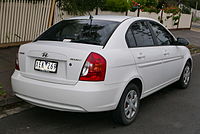
Rear view (sedan)

Front view (hatchback)

Rear view (hatchback)
Safety[]
In 2006, according to the Insurance Institute for Highway Safety, the Accent received an Acceptable overall score in the frontal crash test and a Poor overall score for in the side impact test without its optional side airbags. It didn't perform well even when equipped with side airbags, performance of the car's structure is marginal there would likely be injuries to internal organs, ribs and pelvis.[41][42][43] In 2007, 2006 year model of Hyundai Accent had been tested by ANCAP in June 2007. It scored 3 star in the Occupant Protection, and 2 star in Pedestrian Protection Rating.[44]
Insurance Institute for Highway Safety (IIHS) was safety tested by IIHS in 2009
| Moderate overlap front | Acceptable |
| Side | Poor |
| Roof strength | Acceptable |
| Head restraints & seats | Poor |
Gallery[]

Hyundai Accent SR (sold only in Canada for 2007)
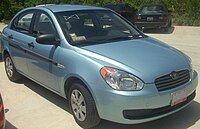
2007–2009 Dodge Attitude (Mexico)
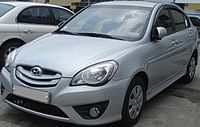
Hyundai Verna Transform (South Korea)

Hyundai Verna Transform (South Korea)
Hybrid[]
Hyundai debuted a demonstration version of a hybrid (MC/JB) Accent[46] at the 2005 Guangzhou International Automobile Exhibition in Guangzhou, China. It uses a 90 hp (67 kW), 1.4 L engine with continuously variable valve timing and a 16 hp (11.9 kW) electric motor to achieve 44% better fuel economy. Though originally scheduled for production release in the 2006 model year, introduction of the production version has been delayed indefinitely, along with the Kia Rio hybrid.[citation needed]
The hybrid Accent is expected to be introduced at the same time as a hybrid version of the Kia Rio, the Kia twin of the Accent. A concept model of the Kia Rio hybrid was shown at the 2007 Geneva Auto Show.[citation needed]
Fourth generation (RB/RC; 2010)[]
| Fourth generation (RB/RC) | |
|---|---|
 | |
| Overview | |
| Also called | Hyundai Verna Hyundai Solaris (Russia) Hyundai i25 Accent (Colombia,[47] Israel) Hyundai Grand Avega (hatchback, Indonesia) Hyundai Excel III (sedan, Indonesia) Hyundai Grand Pony (sedan, Colombia) Dodge Attitude (Mexico)[48] |
| Production | 2010–2019 2012–present (Egypt) |
| Model years | 2011–2018 |
| Assembly | South Korea: Ulsan China: Beijing (Beijing Hyundai) India: Chennai (HMIL) Russia: St. Petersburg (HMMR) Indonesia: Bekasi (HIM) Taiwan: Hukou, Hsinchu (SYM Motors) Iran: Bam, Kerman (KMC) Algeria: Tiaret (TMC) Nigeria: Lagos (HMNL) Mozambique: Matola (Somyoung Motors)[49] |
| Body and chassis | |
| Body style | 4-door sedan 5-door hatchback |
| Platform | Hyundai-Kia PB |
| Related | Hyundai i20 (PB) Hyundai ix20 (OJ) Kia Pegas Hyundai Reina Kia Rio (QB) Kia Rio (UB) |
| Powertrain | |
| Engine |
|
| Transmission | 5-speed manual 6-speed M6CF1 manual 4-speed automatic 6-speed A6GF1 automatic 7-speed DCT CVT |
| Dimensions | |
| Wheelbase | 2,570 mm (101.2 in) |
| Length | 4,115 mm (162.0 in) (hatchback) 4,370 mm (172.0 in) (sedan) |
| Width | 1,705 mm (67.1 in) |
| Height | 1,455 mm (57.3 in) |
| Curb weight | 1,040–1,170 kg (2,292.8–2,579.4 lb) |
Hyundai staged the world-premiere of the fourth generation Accent as the Verna at the 2010 Beijing Auto Show.[50]

Front view (sedan)

Rear view (sedan)

Front view (hatchback)

Rear view (hatchback)
Markets[]
South Korea[]
Hyundai released the Korean version of the Accent (RB series) in November 2010. The new model is offered with the same 1.6-liter engine and 6-speed automatic or 6-speed manual as the fifth-generation (MD) Elantra. The car reverted to the "Accent" name as used in the X3 series.[51] The hatchback version, called Accent WIT, replaces the Getz/Click in South Korea. Sedan model was discontinued since in late 2018; the hatchback model was in August 2018. It was sold until Hyundai Venue launched in July 2019.
China[]
In Beijing, China, Hyundai released the China-exclusive version of this model under the "Verna" name on 23 August 2010 under the model code RC.[52]
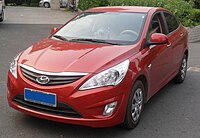
Hyundai Verna sedan (RC, pre-facelift; China)

Hyundai Verna sedan (RC, facelift; China)

Interior
North America[]
In January 2011, the sedan had its North American debut and the hatchback had its world debut at the Montreal Auto Show.[53]
There is one engine option in North America for the Accent, a 1.6 L with 138 hp (103 kW) and 123 lb/ft of torque (2011 - 2017 models). This engine features the gas direct injection technology (1.6 "GDI"). Also, the head and block are made of aluminum.

2012 Hyundai Accent GLS sedan
Australia[]
Australia's Accent was released in August 2011 in three grades consisting of Active, Elite, and Premium in either Sedan or Hatch.[54] All were equipped with a 1.6-litre MPi engine mated to a 5-speed manual or 4-speed automatic, while a 1.6-litre diesel was later added to the Active grade, but dropped shortly after. In 2013, an SR grade was added to replace the Elite and Premium grades and brought in the Gamma 1.6-litre GDi engine to the range. The Active had switched to a 1.4-litre engine and optional CVT to keep costs down due to the discontinuation of the i20 in Australia.
As part of a 2017 upgrade, Hyundai simplified the Accent to just one grade called Sport. The Sport grade combined the SR's 1.6-litre engine, Premium interior materials, mesh-look grille, cruise control, optional 6-speed automatic, and 16" alloy wheels while staying close to the Active's entry price.[55]
As of January 2020, the Accent was removed from the Hyundai Australia website, marking the end of the nameplate's 20 year run with sales reaching a total of 9,963 registered units in its last year on sale.
Russia[]
In September 2010, Hyundai unveiled its Russian assembly line and presented the "Hyundai Solaris" a production-ready local version of the four-door fourth generation Accent. Hyundai reported that production would commence in January 2011.[56] The Accent badge remained reserved for the second generation Accent, that had still been produced in Taganrog in the TagAZ plant at that time. The Hyundai Solaris was available with Gamma 1.4 (107 hp) and Gamma 1.6 (123 hp) petrol engines, with a 6-speed manual or a 4-speed automatic transmission.[57]
In 2014, the Hyundai Solaris for Russian and CIS (where it is sold as the Hyundai Accent) market was facelifted. The car got new front fascia and new 6-speed automatic and 6-speed manual gearboxes for 1.6 version.[58]
India[]
Although Verna was launched in India for the very first time in 2006 but In May 2011, Hyundai launched Verna with four engine options including 1.4-litre petrol and diesel engines as well as 1.6-litre petrol and diesel engines. The second-generation (LC) continues to be sold in India as the Hyundai Accent with the latest RB version carrying the Verna brand. At the time of launch, the new Verna RB features safety and comfort options that were previously unavailable in the Indian market at this price point including the option of 6 airbags.[59] Hyundai refreshed the Indian lineup of Verna in 2014 without any engine changes.[60]
The diesel variant has attracted more attention in India because of its fuel economy. As a result, the response in India was overwhelming.
The Verna is offered with four engine options, 1.4 L VTVT petrol, 1.6 L VTVT petrol, 1.4 L CRDi diesel, and 1.6 L CRDi diesel.
Hyundai launched the Verna facelift in the Indian car market on 18 February 2015.[61] The new Verna mid-sized sedan gets changes to both styling and mechanism. The updated Hyundai Verna gets new front fascia. Apart from the same petrol and diesel engine versions, the four-speed automatic gearbox is likely to be offered in the upcoming model; however, the maker might also introduce the six-speed automatic gearbox.[62]
In 2018, the Hyundai Verna was named Indian Car Of The Year.[63]
Indonesia[]
In Indonesia, the Accent hatchback was sold as the Grand Avega, which made its debut at the 2011 Indonesia International Motor Show and was assembled locally (CKD).[64] The Grand Avega is equipped with two engines and four transmissions: a 1.4-litre Gamma petrol engine producing 108 PS (107 hp) with 4-speed automatic or 5-speed manual (2011–2013) and a 1.4 L petrol 100 PS Kappa engine with 6-speed manual or CVT (2013–2016).[65] Sedan body style also available in Indonesia only for taxi fleet and sold as Excel III, only available with 1.4 L petrol 108 PS Gamma engine and 5-speed manual transmission.[66] In 2016, Grand Avega was replaced by the relatively smaller Hyundai i20.
Mexico[]

In Mexico it was marketed as Dodge Attitude from 2011 to 2014 until May 2014 after Hyundai's arrival in the country, forcing Dodge to give the name Attitude to the Mitsubishi Attrage. The Accent returned to the country in mid-2017 as the 2018 Hyundai Accent.
Philippines[]
In the Philippines, the RB model was launched in 2011. The sedan version was powered by a 108 PS (107 hp) Gamma engine with a choice of a 4-speed automatic or 5-speed manual transmission. Some of first batch of RB models were dogged by knocking issues when using 91 and below octane fuel. A second iteration was introduced in 2014 with a 100 Ps Kappa engine mated to a 6-speed manual or a 4-speed automatic, and a newer 1.6-liter D4FB common rail direct injection turbodiesel with 126 PS (124 hp) and 260 N⋅m (192 lb⋅ft) in either a 6-speed manual or a 4-speed automatic.
The hatchback model was introduced at 2013 exclusively with a 1.6 D4FB common rail direct injection turbodiesel with VGT. Power output is at 126 Ps and 260 N⋅m (192 lb⋅ft). Both the 6-speed manual and 4-speed Automatic models came with anti-lock braking systems (ABS) with electronic brake distribution. By 2014, a facelifted model was introduced with the top-end model getting new projector-type headlamps, ABS and EBD.
In 2015, the diesel variant was upgraded on both sedan and hatchback models with an electronic VGT (e-VGT), mated to a 6-speed manual or a new 7-speed dual-clutch automatic transmission (DCT). Power outputs are now 136 PS (134 hp) and 265 N⋅m (195 lb⋅ft) for the 6-speed manual while the DCT model has the same horsepower but now has 300 N⋅m (221 lb⋅ft) of torque.
Safety[]
The 2012 Hyundai Accent was tested by the IIHS and received a "Good" rating in the frontal offset test, an "Acceptable" rating in the side impact test, and a "Good" rating in the roof strength test. It also received a "Good" rating in the rear crash protection (head restraint) test.[67]
The 2012 Hyundai Accent was tested by the U.S. National Highway Traffic Safety Administration (NHTSA) and received the following:[68]
- Overall Rating:





- Frontal Crash:





- Side Crash:




 *
* - Rollover:





The Hyundai Verna was crash-tested by China NCAP in 2011 and scored the maximum possible 5 stars.[69]
Insurance Institute for Highway Safety (IIHS) was safety tested by IIHS in 2012
| Moderate overlap front driver-side | Poor |
| Moderate overlap front | Good |
| Side | Acceptable |
| Roof strength | Good |
| Head restraints & seats | Good |
Gallery[]

Pre-facelift Hyundai Verna sedan (China)

Facelift Hyundai Verna sedan (China)

Interior
Fifth generation (HC/YC; 2017)[]
| Fifth generation (HC/YC) | |
|---|---|
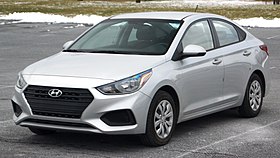 | |
| Overview | |
| Also called | Hyundai Verna Hyundai Solaris (Russia) |
| Production | 2016–present (China) 2017–present |
| Model years | 2017–present (China) 2018–present (North America) |
| Assembly | Mexico: Monterrey, Nuevo Leon (KMMX)[71] India: Chennai (HMIL) Russia: St. Petersburg (HMMR) China: Beijing (Beijing Hyundai) Philippines: Santa Rosa, Laguna (HARI)[72] Vietnam: Ninh Bình (HTMV) Algeria: Tiaret (TMC) |
| Body and chassis | |
| Body style | 4-door sedan 5-door hatchback |
| Platform | Hyundai-Kia K2 |
| Related | Kia Rio (YB) Kia Rio (FB) Hyundai Venue (QX)[73] |
| Powertrain | |
| Engine | |
| Transmission | 6-speed manual 6-speed automatic 7-speed DCT C0GF1 CVT |
| Dimensions | |
| Wheelbase | 2,580 mm (101.6 in) 2,600 mm (102.4 in) (HCi/HCr/YC) |
| Length | 4,190 mm (165.0 in) (hatchback) 4,385 mm (172.6 in) (HC sedan) 4,405 mm (173.4 in) (HCr/YC) 4,440 mm (174.8 in) (HCi) |
| Width | 1,729 mm (68.1 in) |
| Height | 1,450–1,475 mm (57.1–58.1 in) |
| Curb weight | 1,060–1,225 kg (2,337–2,701 lb) |

The fifth-generation Accent has been introduced in China as Verna in late 2016. Production began in the same year with sales started around February 2017. In Russia, where it is known as Solaris as well as in some other CIS markets, the car has been available since March 2017. In India, the car was launched in August 2017 as Verna. It went on sale in the United States in December 2017.
Unlike the previous generations, the fifth-generation Accent is not sold in South Korea due to falling demand; instead the Venue crossover takes its place in 2019.[74] Without supply from South Korea, the Accent was also phased out in Australia, leaving the entry model role to the Venue.[75]
Markets[]
North America[]

The hatchback version of the fifth-generation Accent is not available in the United States market due to poor sales for its predecessor, while sedan version continued to be offered. The hatchback version is available alongside the sedan in Mexico and Canada only.
All models of the Accent sold in the United States and Canada are powered by the same 1.6-litre GDi four-cylinder gasoline engine as its predecessor, though horsepower is down to 130 hp (132 PS; 97 kW) from the previous rating of 138 hp (140 PS; 103 kW). The base SE features a six-speed manual transmission, while a six-speed automatic transmission is optional. The six-speed automatic transmission is standard on the SEL and Limited models.
Features available for the first time on the Accent include forward collision avoidance alert, a touch-screen infotainment system with optional Apple CarPlay, Android Auto, and Hyundai Blue Link, proximity key entry with push-button start, seventeen-inch aluminum-alloy wheels, heated dual front bucket seats, and more.
Power output for the 2020 model year onward has been decreased to 120 hp (122 PS; 89 kW), as the engine was replaced with a new Smartstream 1.6-litre DPi engine with continuously variable valve timing and CVT, replacing the geared automatic transmission.[76]
The Accent was discontinued in Canada in the end of 2020 and was indirectly replaced by the Kona and Venue crossovers, after axing only the sedan model in 2019.[77][78] The Accent sedan remains available in the United States, while both the sedan and hatchback remain available in Mexico.
For 2022, the six-speed manual transmission, only offered in the base SE trim level, was discontinued in the United States.[79]
India[]
Codenamed HCi, the Indian-market version was launched in August 2017 as the Verna.[80] Hyundai claimed the new Verna is underpinned by the K2 platform that is more rigid than the previous-gen model’s platform, citing improvements in NVH levels, crashworthiness and overall stiffness.[81] At launch, the Indian-market Verna was available with the 1.6-litre petrol and diesel engines carried from the previous generation and in four variants. Some of the main features includes 6 airbags, sunroof, handsfree trunk and front ventilated seats.
The 1.6-litre petrol engine produces 123 PS (121 hp; 90 kW) and 151 N⋅m (15.4 kg⋅m; 111 lb⋅ft) of torque and the 1.6-litre diesel producing 128 PS (126 hp; 94 kW) and 260 N⋅m (26.5 kg⋅m; 192 lb⋅ft) of torque. Both are now mated to 6-speed manual transmissions with an optional 6-speed automatic transmission. In 2018, a 1.4-litre diesel engine option was introduced, producing 89 PS (88 hp; 65 kW) and 220 N⋅m (22.4 kg⋅m; 162 lb⋅ft).[82]
The facelifted model was released in March 2020. The Verna features cosmetic changes which include a refreshed front end, new LED headlamps, new rear bumper, revamped LED taillamps, and new dashboard design. Engine options were totally revamped, introducing three new engines. The base option is a 1.5-litre Smartstream MPi petrol which generates 115 PS (113 hp; 85 kW) and 144 N⋅m (14.7 kg⋅m; 106 lb⋅ft) of peak torque, available with a 6-speed manual and CVT. The 1.0-litre Kappa II turbo petrol churns out 120 PS (118 hp; 88 kW) and 172 N⋅m (17.5 kg⋅m; 127 lb⋅ft) output, paired to a 7-speed DCT. The 1.5-litre U2 CRDi diesel delivers 115 PS (113 hp; 85 kW) and 250 N⋅m (25.5 kg⋅m; 184 lb⋅ft), with transmission options of 6-speed manual and 6-speed automatic.[83]
The HCi Accent/Verna is exported throughout Middle East, Africa, and to the Philippines and Vietnam in knock-down kits.[84] In November 2020, the Verna was released in Chile as the new Hyundai Accent. Two months later it was released in Peru with the same name, since the original fifth-generation model was not sold in these countries, keeping the previous generation until 2020.

2020 Hyundai Verna 1.5 SX(O) (HCi, India; facelift)
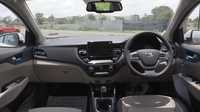
Interior (HCi, facelift)
Russia[]

In late 2017, Hyundai Motor Manufacturing plant in Saint Petersburg started assembling the fifth-generation Solaris. It received renewed engines which are the Kappa 1.4-litre engine producing 100 PS (99 hp; 74 kW) and the 1.6-litre Gamma II engine with 123 PS (121 hp; 90 kW), paired with 6-speed manual or 6-speed automatic transmission.
In 2020, the restyled version of the Solaris was released, featuring a new front design, some additional comfort features and new touchscreen multimedia system. Engines and transmission options remained the same.[85]
China (YC)[]
The Verna was revealed as a concept version at the 2016 Chengdu Auto Show.[86] It was sold from October 2016, with two body styles available which are 4-door sedan and 5-door hatchback, marketed as the Verna RV.[87] The Chinese-market Verna was given a facelift in 2020.

2017 Hyundai Verna (YC, China)

2017 Hyundai Verna (YC, China)

2017 Hyundai Verna RV (YC, China)

2017 Hyundai Verna RV (YC, China)
Powertrain[]
| Model | Years | Transmission | Power | Torque | 0-100 km/h (0-62 mph) (official) |
|---|---|---|---|---|---|
| Petrol | |||||
| 1.0 L Kappa II T-GDi | 2017–present | 7-speed DCT | 120 PS (88 kW; 118 hp) at 6,000 rpm | 17.5 kg⋅m (172 N⋅m; 127 lbf⋅ft) at 1,500-4,000 rpm | |
| 1.4 L Kappa II MPi | 6-speed manual 6-speed automatic |
100 PS (74 kW; 99 hp) at 6,000 rpm | 13.5 kg⋅m (132 N⋅m; 98 lbf⋅ft) at 4,000 rpm | 12.2s (Manual) 13.4s (Automatic) | |
| 1.5 L Smartstream MPi | 6-speed manual CVT |
115 PS (85 kW; 113 hp) at 6,300 rpm | 14.7 kg⋅m (144 N⋅m; 106 lbf⋅ft) at 4,500 rpm | ||
| 1.6 L Gamma II MPi | 6-speed manual 6-speed automatic CVT |
123 PS (90 kW; 121 hp) at 6,300 rpm | 15.4 kg⋅m (151 N⋅m; 111 lbf⋅ft) at 4,850 rpm | 10.3s (Manual) 11.3s (Automatic) | |
| 1.6 L Gamma II GDi | 6-speed manual 6-speed automatic |
132 PS (97 kW; 130 hp) at 6,300 rpm | 16.4 kg⋅m (161 N⋅m; 119 lbf⋅ft) at 4,850 rpm | 10.1s (Manual) 10.5s (Automatic) | |
| 1.6 L Smartstream DPi | 2020–present | 6-speed manual CVT |
122 PS (90 kW; 120 hp) at 6,300 rpm | 15.6 kg⋅m (153 N⋅m; 113 lbf⋅ft) at 4,500 rpm | |
| Diesel | |||||
| 1.5L U II CRDi | 2017–present | 6-speed manual 6-speed automatic |
115 PS (85 kW; 113 hp) at 4,000 rpm | 25.5 kg⋅m (250 N⋅m; 184 lbf⋅ft) at 1,500-2,750 rpm | |
Safety[]
Insurance Institute for Highway Safety (IIHS) was safety tested by IIHS in 2018
| Small overlap front: driver-side | Good |
| Small overlap front: passenger-side | Acceptable |
| Moderate overlap frontal offset | Good |
| Small overlap frontal offset | Good |
| Side | Good |
| Roof strength | Good |
| Head restraints & seats | Good |
Motorsport[]
WRC[]
Hyundai's Accent World Rally Car, Accent WRC, competed in an official capacity, spawning three generations, in the World Rally Championship from 2000 to 2003.[89]
Junior Formula series[]
In India, Hyundai is the sole engine supplier for Formula LGB Hyundai, built by the Chain and Sprocket giant LGB. The single make series is promoted at grassroots level acting as a launch pad for future Formula One hopefuls. The Accent engine is supplied in Stock form albeit after some engine control unit modifications.[citation needed]
X3 Excel in Australia[]
In Australia, the X3 Accent is sold as the Hyundai Excel and is used in the Excel Rally Series, beginning in 2005. There are restrictions on modifications to the vehicle to reduce cost and encourage competition.
Similarly in 2010, a circuit racing competition began in Queensland called Excel Cup and soon after in South Australia called Circuit Excels. The class has since spread to all six states with several hundred race cars built nationally. A single event nationals has been created to bring all six states together for a single race meeting annually. They are the cheapest racing class in Australia based on a production road car.
Sales[]
| Calendar Year | United States[90] | Canada[91] | South Korea[92] | China[93][94][95] | Vietnam[96] |
|---|---|---|---|---|---|
| 2002[97] | 71,488 | ||||
| 2003 | 56,585 | ||||
| 2004 | 43,258 | 19,172 | |||
| 2005 | 41,012 | 15,679 | |||
| 2006 | 34,735 | 17,784 | |||
| 2007 | 36,735 | 16,390 | 26,548 | ||
| 2008 | 50,431 | 29,751 | 24,628 | ||
| 2009 | 68,086 | 25,220 | 60,379 | ||
| 2010 | 51,975 | 24,017 | 112,822 | ||
| 2011 | 55,601 | 22,280 | 23,923 | 158,082 | |
| 2012 | 61,004 | 22,581 | 30,527 | 206,790 | |
| 2013 | 60,458 | 18,884 | 28,604 | 199,065 | |
| 2014 | 63,309 | 23,173 | 23,206 | 236,024 | |
| 2015 | 61,486 | 19,371 | 18,267 | 213,678 | |
| 2016 | 73,766 | 19,198 | 12,430 | 156,902 | |
| 2017 | 58,955 | 13,073 | 7,493 | 99,542 | |
| 2018 | 29,090 | 7,067 | 5,698 | 35,821 | |
| 2019 | 25,628 | 5,989 | 4,094 | 37,549 | 19,719[98] |
| 2020 | 15,975 | 3,018 | 27,156 | 21,602[99] |
References[]
- ^ Fiala, Jiří; Strossa, Petr (2019). Automobily Jména, značky a znaky: Význam jmen a značek, loga, přehled typů, historie a zajímavosti [Cars: names, brands and characters - The meaning of the brands, logos, overview of types, history and attractions] (in Czech). Grada Publishing a.s. p. 38. ISBN 9788024753157. Retrieved 28 October 2020.
- ^ a b Hyundai Accent Named Most Dependable Sub-Compact Car By J.D. Power and Associates 7 August 2008, Reuters
- ^ "2005 Kia Qianlima 06 - Gallery–China automotive news". Autonews.gasgoo.com. Retrieved 25 July 2010.
- ^ "KIA Qianlima - 836570 - Product Catalog - Aikar Car Renting Co., Ltd. Jinjiang, Fujian - - DIYTrade.com Free Website". Icar.diytrade.com. Archived from the original on 10 July 2011.
- ^ "Dongfeng Yueda Kia. Dongfeng Yueda Kia in China". Car-cat.com. Retrieved 25 July 2010.
- ^ Robertson, Don. "Hyundai plant revving up to make new inroads in SA". Btimes.co.za. Archived from the original on 27 September 2011.
- ^ a b "Hyundai. Hyundai in Egypt". Car-cat.com. Retrieved 25 July 2010.
- ^ "Company Profile". Hyundai Indonesia. Archived from the original on 18 August 2011.
- ^ a b "Hyundai. Hyundai in Turkey". Car-cat.com. Retrieved 2 August 2010.
- ^ "Used 1996 Hyundai Accent GT Features & Specs". Edmunds. Retrieved 8 June 2015.
- ^ "Hyundai Excel 1994". Drive.com.au. 28 November 2005. Retrieved 10 January 2015.
- ^ "Used car review Hyundai Excel 1994-2000". Carsguide.com.au. 28 January 2009. Retrieved 10 January 2015.
- ^ "Hyundai X3 Excel Hatch/Sedan (1994-2000)". Motoring.com.au. 1 April 2005. Retrieved 10 January 2015.
- ^ Cocosila, Mihail (16 February 1998). "Dacia prepares for Hyundai engine". europe.autonews.com.
- ^ a b Alfan, Charis (9 June 2016). "Hyundai Accent/Bimantara Cakra X3". www.mobilmotorlama.com (in Indonesian).
- ^ "Kia Qianlima specs".
- ^ a b c "1st generation LHD Hyundai Accent 4dr hatchback crash test". EuroNCAP.
- ^ "Tester & Goda råd: Hur säker är bilen (Bilguide)" [Tests and Advice: How safe the car is (Car Guide)] (in Swedish). Folksam.
- ^ a b c "Hyundai Zahlen und Fakten 2008" [Hyundai Numbers and Facts] (PDF) (in German). Hyundai Presselounge. 16 September 2008. p. 13. Retrieved 18 April 2013.
- ^ "Hyundai India Makes Accent (LC) to Live until 2017". Drivespark. 28 March 2013. Retrieved 26 December 2013.
- ^ "Taganrog-made Hyundai Cars Vanished from Car Dealers". Wroom.ru. 25 September 2012. Archived from the original on 6 March 2016.
- ^ "Модельный ряд" [Model line-up]. TagAZ. Retrieved 18 April 2013.
- ^ "ТагАЗ: Accent" (in Russian). Tagaz.ru. Retrieved 25 July 2010.
- ^ "GIAD Vehicles Co. Ltd". Giadauto.com. Retrieved 24 November 2010.
- ^ "Annual Report 2004" (PDF). Hyundai Motor Company. 1 August 2005. p. 58. Retrieved 18 April 2013.
- ^ "HYUNDAI. HYUNDAI in INDONESIA". Car-cat.com. Archived from the original on 18 August 2011.
- ^ Chauhan, Chanchal Pal (5 February 2014). "Hyundai joins compact sedan race with Xcent in muted Indian market". The Economic Times. Retrieved 14 February 2014.
- ^ "2nd generation RHD Hyundai Accent 5dr hatchback crash tested by ANCAP under Euro NCAP regulations".
- ^ АВТОРЕВЮ | Доверяйте профессионалам! (in Russian). Autoreview.ru. Retrieved 24 November 2010.
- ^ "Accent – на безопасность" (in Russian).
- ^ "Hyundai Accent (Mar 2003 – Jun 2005) Crash Test Results".
- ^ "2013 Quick Facts". Hyundai Motor Company. 21 February 2013. Retrieved 14 April 2013.
- ^ "Hyundai Verna Price in India, Photos & Review". CarWale. Retrieved 26 December 2013.
Discontinued Hyundai Verna Versions: Hyundai Verna Transform (2010-2011)
- ^ "Accent Era Kazanmak İçin Son Gün 5 Şubat!!!" (in Turkish). Hyundai Assan Otomotiv. 31 January 2006. Retrieved 8 October 2013.
- ^ "Yeni nesil i20'yi de üretip, ikinci modele sonra karar vereceğiz". Milliyet (in Turkish). 20 February 2012. Retrieved 8 October 2013.
- ^ "Passenger Cars". Bogdan Corporation. Archived from the original on 27 December 2013. Retrieved 18 April 2013.
Under the licenses, the Corporation assembling 10th family's LADA cars, Hyundai Tucson, Elantra XD и Accent on its production sites.
- ^ https://www.hyundainews.com/en-us/releases/855
- ^ https://www.hyundainews.com/en-us/releases/855
- ^ "Build Your Own Accent, Sonata, Elantra, Santa Fe, Genesis & More | Hyundai". Hyundaiusa.com. Archived from the original on 23 March 2010.
- ^ Elliott, Hannah (21 October 2010). "Cars That Lose Their Value Fastest". Forbes.
- ^ First crash tests of minicars 19 December 2006
- ^ "IIHS-HLDI: Hyundai Accent". Iihs.org. 25 November 2008. Retrieved 23 April 2009.
- ^ "IIHS-HLDI: Hyundai Accent". Iihs.org. 25 November 2008. Retrieved 23 April 2009.
- ^ "ANCAP Crash Test – Hyundai Accent 2006 onwards". Archived from the original on 27 September 2007. Retrieved 16 August 2007.
- ^ IIHS (Hyundai Accent)
- ^ "Archived copy". Archived from the original on 24 April 2010. Retrieved 22 July 2010.CS1 maint: archived copy as title (link) List of hybrid vehicles equipped with Panasonic charge batteries
- ^ "Hyundai lanzó en Colombia el i25 Accent" [Hyundai launches the i25 Accent in Colombia]. Automóviles Colombia (in Spanish). 23 April 2011. Archived from the original on 19 March 2011.
- ^ Ewing, Steven J. (26 May 2011). "Dodge updates Attitude for Mexico with latest Hyundai Accent, forgets badges". Autoblog.com. Retrieved 1 June 2011.
- ^ "Partnership between Mozambique and South Korea Assembles Hyundai Cars". MacauHub. 7 November 2014. Retrieved 4 January 2015.
- ^ "New Hyundai Accent (Verna): Mini-Me Sonata Debuts at Beijing Motor Show". Carscoops. 23 April 2010. Retrieved 13 December 2020.
- ^ Pettendy, Marton (4 November 2010). "Accent to fill Getz shoes for Hyundai". GoAuto. John Mellor. Archived from the original on 30 December 2010. Retrieved 4 November 2010.
- ^ "Beijing Hyundai Releases Fourth Generation Accent–Verna". BBC News. 10 June 2009. Retrieved 14 July 2010.
- ^ "2012 Hyundai Accent Gets Most Power, Fuel Economy in its Class [Montreal Auto Show]". 13 January 2011. Retrieved 18 February 2011.
- ^ "Review: Hyundai RB Accent (2011-2018)". Retrieved 6 January 2019.
- ^ Chesterton, Andrew (1 December 2017). "Hyundai Accent Sport 2018 review: snapshot". CarsGuide. Retrieved 6 January 2019.
- ^ Hyundai Reveals Russian Production-Spec Accent, Calls it Solaris. Motor Trend, 22 September 2010. Retrieved 22 September 2010.
- ^ "За чем стоим?". 2011. Archived from the original on 8 September 2011. Retrieved 24 February 2012.
- ^ "Prices for updated Hyundai Solaris were announced". Wroom.ru. 17 June 2014. Archived from the original on 5 December 2014.
- ^ Hyundai Accent launched. Many engines, even more variants! Archived 11 September 2011 at the Wayback Machine. www.carmayogi.in, 11 May 2011. Retrieved 12 May 2011.
- ^ "Hyundai Verna 2014". Retrieved 25 March 2014.
- ^ "2015 Hyundai Verna facelift launch". CarTrade. 18 February 2015. Retrieved 18 February 2015.
- ^ "Official: Hyundai Verna facelift launching on February 18". CarTrade. 10 February 2015. Retrieved 11 February 2015.
- ^ "Hyundai Verna wins the ICOTY (Indian Car Of The Year) 2018 - Overdrive". Overdrive. Retrieved 10 March 2018.
- ^ "Hyundai Grand Avega CKD, Harganya Bisa Ditekan". Retrieved 14 July 2012.
- ^ "Review Spesifikasi, Kelebihan dan Kekurangan Hyundai Grand Avega".
- ^ "Hyundai Excell III Taxi Siap Hadang Laju Limo".
- ^ "IIHS-HLDI: Hyundai Accent". Iihs.org. Retrieved 15 January 2012.
- ^ "2012 Hyundai Accent 5 HB FWD | Safercar - NHTSA". Safercar.gov. Retrieved 15 January 2012.
- ^ "2011 Hyundai Verna crash test by China NCAP".[permanent dead link]
- ^ IIHS (Hyundai Accent)
- ^ "Llega el coreano con sangre mexicana: Accent de Hyundai". Vanguardia. 11 August 2017. Retrieved 25 August 2017.
- ^ "Hyundai Assembly Center". Hyundai Philippines. Retrieved 28 January 2021.
- ^ Blanco, Sebastian. "2020 Hyundai Venue: Test Drive Review Proves Money Isn't Everything". Forbes. Retrieved 22 October 2019.
- ^ https://www.hyundai.com/kr/en/suv/venue
- ^ "How Hyundai left cheap and cheerful behind". CarsGuide. Retrieved 23 June 2021.
- ^ https://www.motor1.com/news/361191/2020-hyundai-accent-engine-gearbox/
- ^ "Hyundai Canada announces Accent will not return in 2021 | Car News | Auto123". auto123.com. Retrieved 23 June 2021.
- ^ "The Hyundai Accent is being killed off in Canada after 26 years". Driving. 31 July 2020. Retrieved 23 June 2021.
- ^ "Another Manual Transmission Has Died, This Time From Hyundai". Motor1.com. Retrieved 10 September 2021.
- ^ "2017 Hyundai Verna launched at Rs 7.99 lakh". Autocar India. Retrieved 20 December 2020.
- ^ "2017 Hyundai Verna launched at Rs 7.99 lakh". Autocar India. Retrieved 20 December 2020.
- ^ "Hyundai Verna Gets New 1.4 Diesel Engine And Two New Automatic Variants". carandbike. Retrieved 20 December 2020.
- ^ Singh, Prashant (30 March 2020). "2020 Hyundai Verna facelift launched, price details inside". Hindustan Times Auto News. Retrieved 20 December 2020.
- ^ "Hyundai India exports 2,022 units of Verna in Saudi Arabia - ET Auto". ETAuto.com. Retrieved 20 December 2020.
- ^ "Hyundai Solaris 2020: все его изменения (некоторые - спорные)" [Hyundai Solaris 2020: all its changes (some - controversial)]. www.zr.ru. Retrieved 13 December 2020.
- ^ Sukesh (18 October 2016). "2017 Hyundai Verna Launched In China". www.drivespark.com. Retrieved 9 February 2021.
- ^ "2017 Hyundai Verna hatchback debuts in China". Indianautosblog. 18 October 2016. Retrieved 9 February 2021.
- ^ IIHS (Hyundai Elantra)
- ^ "Hyundai to quit World Rally". BBC Sport. 17 September 2003. Retrieved 12 November 2019.
- ^ "Hyundai Accent US car sales figures". carsalesbase.com. 6 November 2015. Retrieved 13 December 2020.
- ^ Model. "Hyundai Accent Sales Figures". GCBC. Retrieved 13 December 2020.
- ^ "Sales Performance | IR Activities | IR | Company | Company - Hyundai Worldwide". hyundai motor company, hyundai worldwide, ir, activities, sales performance. Retrieved 4 October 2020.
- ^ "Hyundai Accent China auto sales figures". carsalesbase.com. 22 April 2015. Retrieved 13 December 2020.
- ^ "Hyundai Verna China auto sales figures". carsalesbase.com. 22 April 2015. Retrieved 13 December 2020.
- ^ "Hyundai Verna Yuena China auto sales figures". carsalesbase.com. 14 November 2016. Retrieved 13 December 2020.
- ^ "Hyundai Accent Vietnam auto sales figures". xeoto.com.vn. Archived from the original on 28 January 2021. Retrieved 28 January 2021.
- ^ Good Car Bad Car (Hyundai Accent Sales Figures)
- ^ "Hyundai Accent Vietnam Sales 2019". xeoto.com.vn. Archived from the original on 28 January 2021. Retrieved 28 January 2021.
- ^ "Hyundai Accent Vietnam Sales 2020". xeoto.com.vn. Archived from the original on 28 January 2021. Retrieved 28 January 2021.
External links[]
| Wikimedia Commons has media related to Hyundai Accent. |
- Official website (sedan)
- Official website (hatchback)
- Hyundai vehicles
- Cars introduced in 1994
- 2000s cars
- 2010s cars
- 2020s cars
- Subcompact cars
- Sedans
- Hatchbacks
- Front-wheel-drive vehicles
- Vehicles with CVT transmission




















































